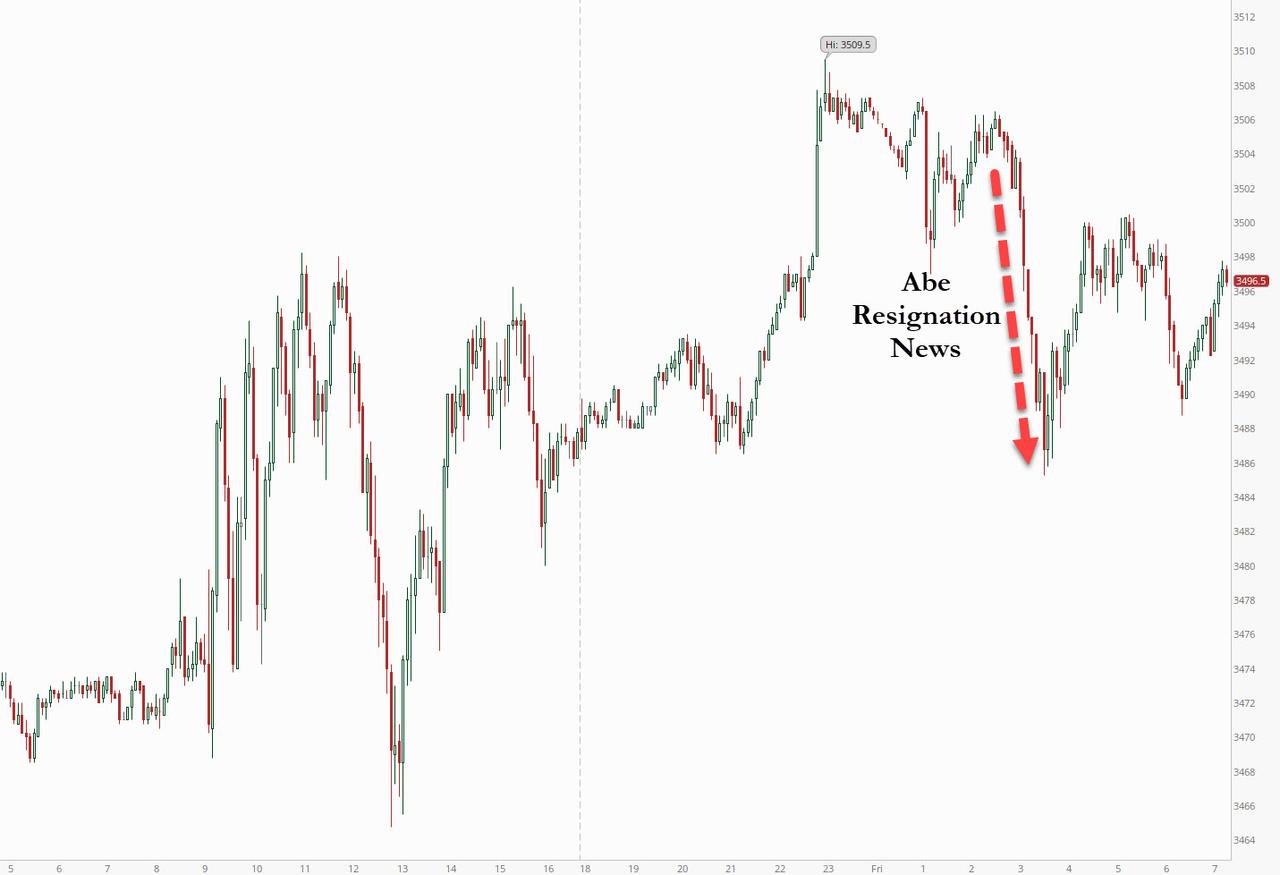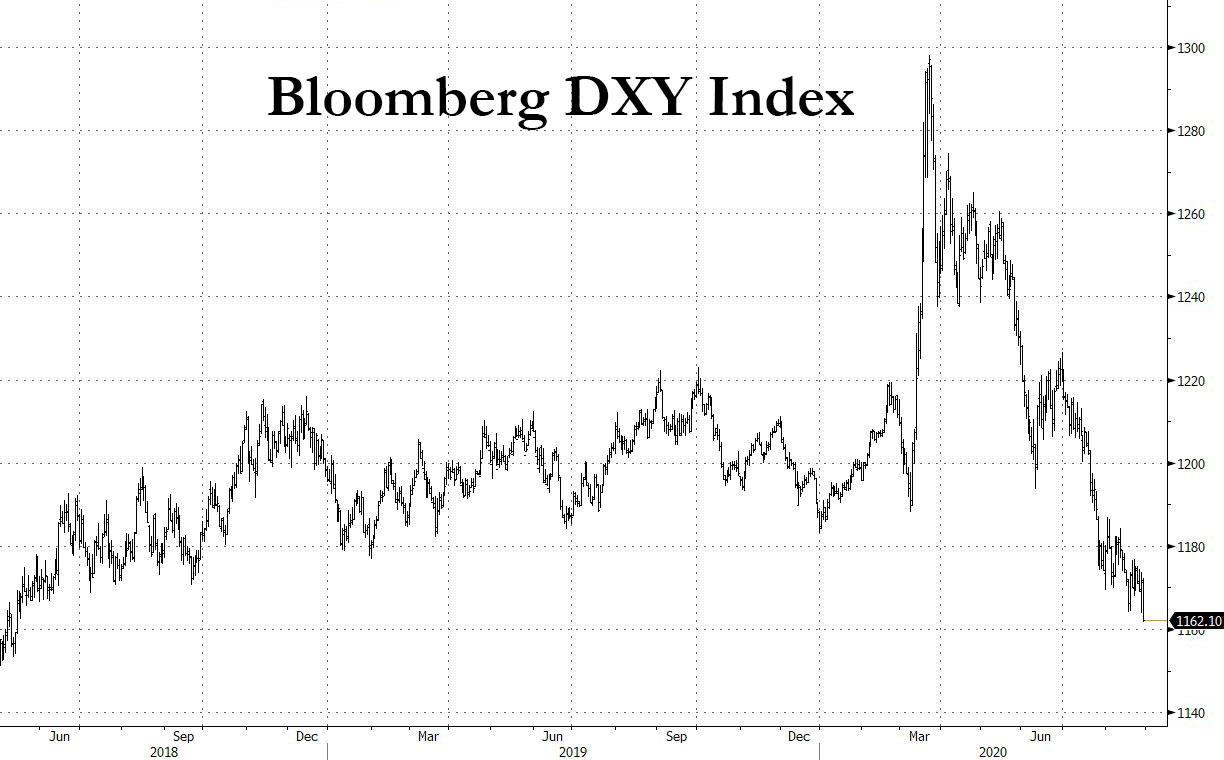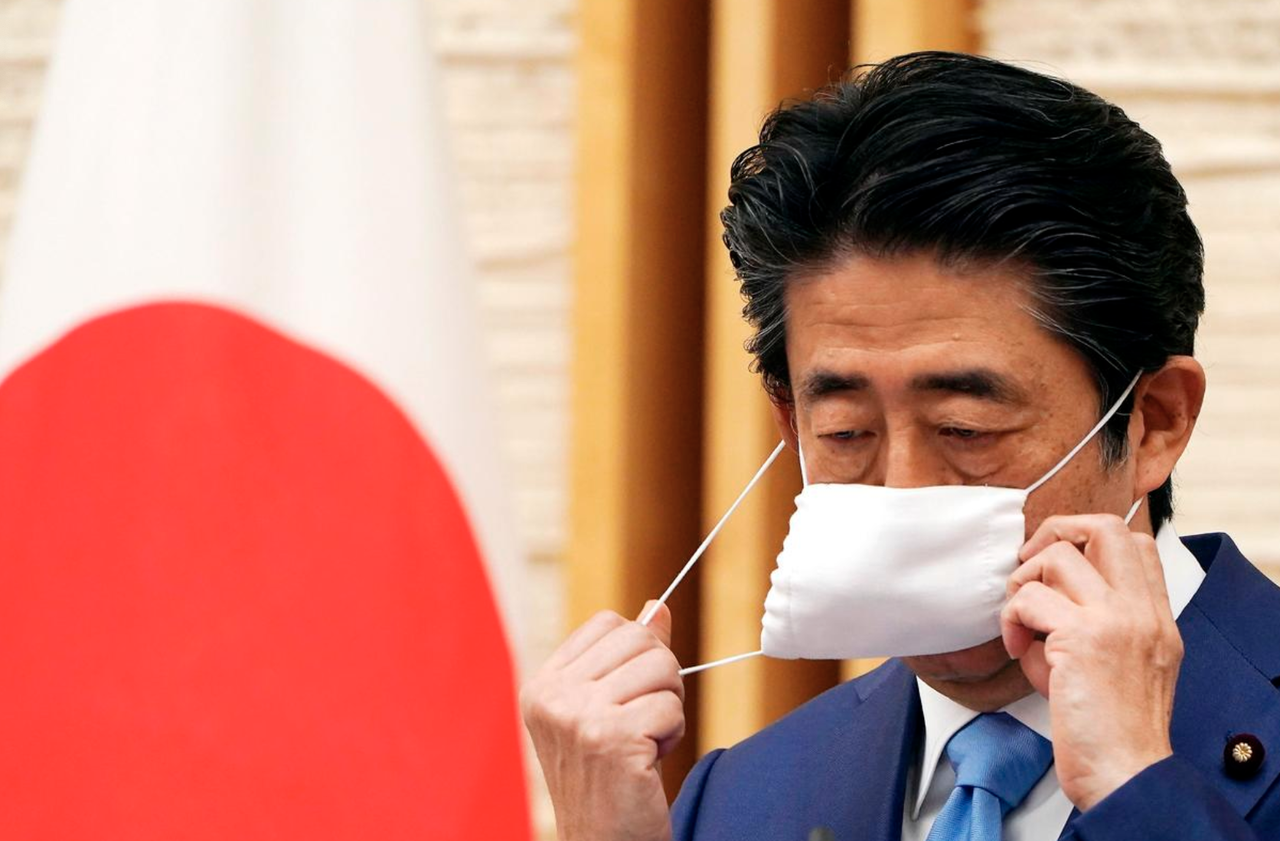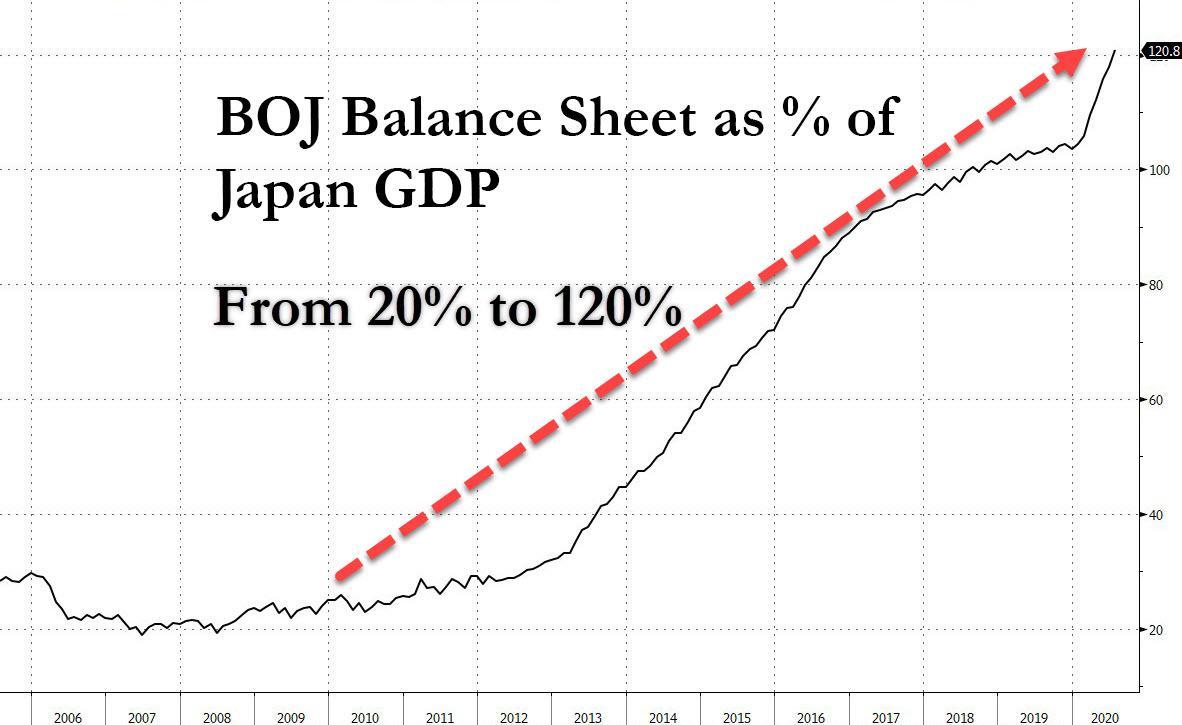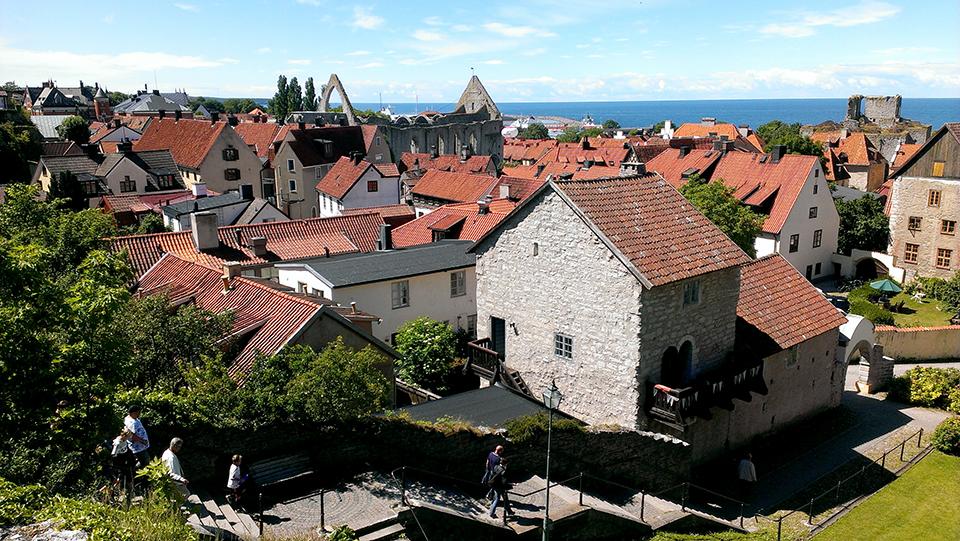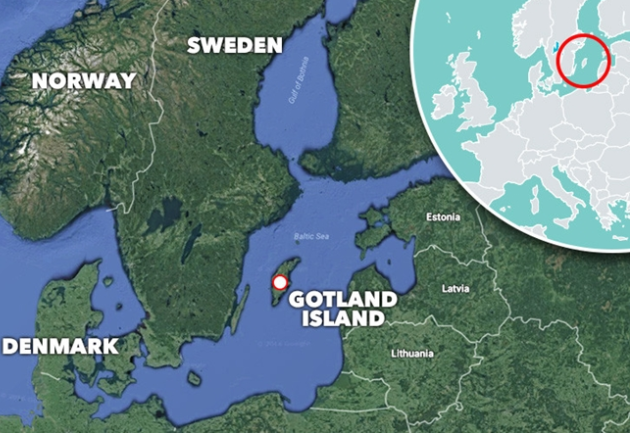S&P Futures Hit Record Above 3,500 As Dollar Tumbles To 27 Month Low
Tyler Durden
Fri, 08/28/2020 – 07:53
After sprinting out of the gates and surging as high as 3,509 during Trump’s acceptance speech, the E-Mini S&P future faded some of its gains even as it remained green for a seventh straight day as investors worried about a lack of detail in the U.S. Federal Reserve’s policy shift which assured super low interest rates for years to come. Despite continued US levitation European and Asian markets were mixed, while Japanese markets were roiled as Prime Minister Shinzo Abe resigned for health reasons (again) sending the Yen surging. The dollar was headed for its worst daily decline in a month.
Futures initially jolted higher as investors bet interest rates would remain low for longer and more stimulus was likely. But markets have since been choppy, with some traders disappointed that the Fed did not reveal more details about how the new framework will work or provide any clues as to what it will do at its next policy meeting.
“It’s not so much about what to do about inflation when it comes but about getting inflation above target. The challenge is to get inflation up to target and not very much was said about that,” said Colin Asher, a senior economist at Mizuho.
The S&P 500 and the Nasdaq are on track for their fifth consecutive week of gains, but the Dow is still about 3.6% from its February all-time high. The Fed on Thursday unveiled a new policy aim for 2% inflation on average so that too low a pace would be followed by an effort to lift inflation “moderately above 2% for some time” and to restore the economy to full employment. In the previous session, the Dow briefly turned positive on the year, while the S&P 500 closed at a record level even as the U.S. economy struggles to recover, forcing the Fed to adopt an unprecedented policy of accepting inflation overshoots for an unknown period of time.
In further proof that technology companies are booming in the pandemic, business software provider Workday jumped 11.2% in premarket trading after raising its annual subscription forecast. Dell Technologies gained 4.5% after reporting quarterly profit that beat expectations as remote working and online learning boosted demand for its notebooks and software products. Cosmetics retailer Ulta Beauty Inc ULTA.N jumped 15.1% after posting quarterly profit ahead of market expectations.
The Euro Stoxx 50 recovered from earlier losses and was last up 0.03%, while Germany’s DAX slid 0.49%. Britain’s FTSE 100 was 0.4% higher.
Earlier, Asian stocks were little changed, with communications falling and finance rising, after falling in the last session. Asian shares outside of Japan limped higher, with the MSCI’s broadest index of Asia-Pacific shares outside Japan gaining 0.19%. Markets in the region were mixed, with Shanghai Composite and Singapore’s Straits Times Index rising, and Australia’s S&P/ASX 200 and Japan’s Topix Index falling. The Topix declined 0.7%, with TerraSky and Airtrip falling the most. Japanese shares dropped, with the Nikkei 225 down 1.4%. Abe resigned on Friday because of a chronic health condition, saying he would stay as prime minister until a new leader was appointed.
“This is a negative for Japanese stocks because it raises questions about what polices come next. We do see the familiar pattern of falling stocks pushing up the yen,” said Junichi Ishikawa, senior foreign exchange strategist at IG Securities in Tokyo. The yen, seen as a safe-haven currency to buy in times of uncertainty, surged to 105.32, gaining 150 pips on the session.
The Shanghai Composite Index rose 1.6%, with Western Superconducting and Whirlpool China posting the biggest advances.
In rates, Treasuries pared overnight losses as the US session gets underway after bear-steepening during Asia session, extending the response to Fed Chair Powell’s comments Thursday. A selloff in Aussie bonds weighed initially, with impact fading during European morning as U.S. stock futures pulled back from record highs. Treasuries remain cheaper by more than 1bp at long end while yields out to 10-year are richer on the day; bunds lag by ~1bp while gilts keep pace. The 5s30s curve steepened as much as 5.5bp to 125bp, highest since June 5 when it reached 128.5bp, steepest since 2006; 2s10s peaked at 62.5bp, steepest since June 9.
In FX, the dollar slumped 0.6% against a basket of other currencies, dropped to a more than two year low. The greenback has fallen sharply since June as many analysts are predicting more pain ahead given U.S. rates are likely to stay low for longer and the political uncertainty before the U.S. presidential election in November.
Residual or more month end rebalancing could be a factor behind the renewed Greenback weakness, though the aforementioned Yen revival has certainly contributed to the dollar reversing further from Thursday’s post-Fed chair policy revelation recovery highs to lower lows. The DXY index is now 100+ ticks down at 92.279 and the ytd trough looms (92.124) amidst broad and increasingly heavy losses across the board, as US stock futures continue to rally or consolidate near record peaks. The euro seized on the dollar’s weakness to gallop another 0.7% higher and was last at $1.1905, close to a more than two-year high it recently touched. The yen soared to 105.35 yen per dollar on news of Abe’s resignation.
On the back of dollar weakness, China’s yuan was on pace for a fifth weekly advance, the longest run since November last year, as the greenback stays weak. The currency traded onshore has risen 0.8% over the past five sessions, taking the climb since July 24 to 2.2%. The yuan jumped as much as 0.48% to 6.8612 a dollar on Friday to trade at its highest since January.
In commodities, Crude oil prices dipped as a massive storm raced inland past the heart of the U.S. oil industry in Louisiana and Texas without causing any widespread damage to refineries. Brent crude fell 0.47% to $44.88 a barrel. U.S. West Texas Intermediate crude dropped 0.49% to $42.83 per barrel. Gold prices bounced 1%, with the spot price at $1,949 an ounce. The precious metal tends to perform well when the dollar is weak and the U.S. central bank sends a dovish message on the future path of interest rates.
Expected data include wholesale inventories and personal income and spending. Big Lots is reporting earnings.
Market Snapshot
- S&P 500 futures up 0.4% to 3,500.00
- MXAP up 0.05% to 173.56
- MXAPJ up 0.2% to 577.53
- Nikkei down 1.4% to 22,882.65
- Topix down 0.7% to 1,604.87
- Hang Seng Index up 0.6% to 25,422.06
- Shanghai Composite up 1.6% to 3,403.81
- STOXX Europe 600 down 0.3% to 369.59
- German 10Y yield rose 2.1 bps to -0.386%
- Euro up 0.8% to $1.1917
- Italian 10Y yield rose 0.3 bps to 0.894%
- Spanish 10Y yield rose 0.4 bps to 0.393%
- Sensex up 0.9% to 39,453.11
- Australia S&P/ASX 200 down 0.9% to 6,073.81
- Kospi up 0.4% to 2,353.80
- Brent futures down 0.2% to $44.98/bbl
- Gold spot up 1.4% to $1,956.80
- U.S. Dollar Index down 0.7% to 92.35
Top Overnight News from Bloomberg
- Abe announced he plans to step down for health reasons, after eight years at the head of Japan
- The Jackson Hole symposium is set to continue after Fed Chairman Powell’s speech on Thursday shook the dollar and longer-dated treasuries overnight
- The number of Americans killed by Covid-19 exceeded 180,000, while the resurgence continues in Europe, with Germany reporting a daily increase in cases close to a four-month high
Snapshot of key global markets courtesy of NewsSquawk:
Asian bourses eventually traded mixed as markets digested the Fed’s shift to an average inflation targeting framework, which briefly lifted the S&P 500 to the 3500 level for the first time ever and the Nasdaq to a fresh record intraday high during Wall Street hours. Some of the moves were then reversed as the dust settled and the recent big tech rally stalled – which dragged the Nasdaq into the red, although US equity futures have since caught a second wind overnight with E-mini S&P taking its turn to breach the 3500 milestone. As such, Nikkei 225 (-1.4%) was initially lifted as exporters benefitted from currency weakness, but plunged heading into the cash close amid reports that Japanese PM Abe is planning to resign due to worsening health conditions, while the Hang Seng (+0.6%) and Shanghai Comp. (+1.6%) were supported after this week’s liquidity efforts resulted to a net weekly injection of CNY 200bln and amid a deluge of earnings including blue-chip names PetroChina, and China Vanke, whose shares all traded higher despite posting varied results. Conversely, ASX 200 (-0.9%) bucked the trend as weakness in Australia’s tech and miners spearheaded the declines in the index, with sentiment not helped by the continued deterioration in ties with its largest trading partner China after Canberra’s move to veto the Belt & Road Initiative agreement, while China also suspended imports of beef from Australia’s John Dee after finding a banned substance. Finally, 10yr JGBs were lower amid spill-over selling from USTs which were heavily pressured as participants contemplated over the Fed’s tolerance for overshooting inflation, to push the US 10yr yield to its highest since mid-June, while the unprecedented levels seen in the E-mini S&P and a tepid BoJ Rinban announcement added to the dampened mood for bonds.
Top Asian News
- New Zealand Deploys Spy Agency as Hackers Hit Stock Market
- Goldman Pays Malaysia $2.5 Billion; Funds to Repay 1MDB Debt
- Xiaomi’s Stock Surge a Big Reversal After Post-IPO Struggles
- SoftBank Group to Sell $12.5 Billion of Wireless Unit Stock
European stocks see choppy price action, although bourses ultimately trade mixed/subdued (Euro Stoxx 50 -0.5%), as the region came under pressure after the cash open and subsequently nursed some of this downside – with little initial follow-through for European bourses from surprise reports that Japanese PM Abe will be stepping down from his position due to ill health. Participants must be wary of month-end rebalancing, although UBS suggests that this August flows are likely to be considerably less eventful than in July; “This month has seen lower levels of dispersion in global equity markets so far, with the model showing only CAD and NZD expected to see tangible buying pressure at month-end as local equity markets have underperformed SPX.” Overall, Core European bourses see little by way of under/outperformers, although peripheries, i.e. Spain’s IBEX (+0.7%) and Italy’s FTSE MIB (+0.2%) stand as the winners aided by their exposures to the financial sector – which is seeing clear outperformance in Europe amid the high yield environment. Overall, European sectors are mostly lower with no clear risk profile to be extrapolated, although tech resides as the laggard following a week of firm gains. In terms of individual movers; Bayer (-3.3%) sees losses after a judge overseeing the Roundup dispute remarks that they may consider lifting the ban on litigation proceedings as a consumer lawyer says Bayer are not abiding by the USD 11bln settlement, according to sources. Enel (+0.2%) is propped up by reports that Macquarie is reportedly working on a binding offer for the Co’s 50% stake in Open Fiber, according to Il Sole 24.
Top European News
- European Equities Set for Pain if Euro’s Advance Nears $1.30
- Apartment Prices Surge in Russia, Raising Fears of a Bubble
- World’s Biggest Wealth Fund to Publish All Vote Plans by 2021
- Sweden’s Historic Crisis Plan Exposes Central Bank’s Limits
In FX, the yen was in focus after Japanese PM Abe announced that he will stand down before his official term ends due to a recurring health problem. In response, Japanese stocks and bonds have fallen on concerns that his brand of expansive policy may not be replicated by the next leader, while the Yen has rebounded firmly with Usd/Jpy sub-106.00 ansd testing support/underlying bids ahead of 105.50 from almost a big figure above and the headline pair decisively through decent option expiry interest between 106.50-60 (1 bn) in advance of the NY cut.
- DXY – Residual or more month end rebalancing could be a factor behind the renewed Greenback weakness, though the aforementioned Yen revival has certainly contributed to the Buck reversing further from Thursday’s post-Fed chair policy revelation recovery highs to lower lows. Indeed, the index is now 100+ ticks down at 92.279 and the ytd trough looms (92.124) amidst broad and increasingly heavy losses across the board, as US stock futures continue to rally or consolidate near record peaks. Ahead, PCE price metrics may well take on greater importance given the switch to average inflation targeting with flexibility, but from a more timely activity perspective Chicago PMI and any big revision to final Michigan sentiment will also be worth watching.
- AUD/NZD/EUR/GBP/CHF/CAD – Understandably, all benefiting from their US rival’s demise, albeit to varying degrees. The Aussie has breached 0.7300 and the Kiwi is edging closer to 0.6700, while the Euro has rotated over 360 degrees again only this time from the low 1.1800 area to 1.1900+. Similarly, Cable is nudging nearer 1.3300 from under 1.3200 at one stage and setting minor new 2020 highs in the process, regardless of latest negative sounding Brexit news like senior EU sources claiming a 2 week ultimatum for UK PM Johnson to salvage post-transition trade and security negotiations. Elsewhere, the Franc is eyeing 0.9000 compared to 0.9100 at the other extreme following a significantly better than forecast Swiss KOF leading index and the Loonie has pared more recent declines to trade circa 1.3060 in the run up to Canadian Q2 GDP.
- SCANDI/EM – The Sek and Nok have resumed bullish trajectories regardless of Euro strength elsewhere, with the former encouraged by Swedish Q2 GDP contracting a tad less than envisaged, while EM currencies are taking advantage of Usd depreciation almost across the board, as the Zar recovers alongside Gold and even the Try regroups with some assistance from an improvement in Turkish consumer sentiment.
In commodites, WTI and Brent front month futures trade relatively flat in early European hours, with some earlier downside coinciding with losses in stocks in what seems to be a sentiment-driven move; albeit, the magnitude of the price action across the oil complex has been minimal. Focus has now shifted away from developments in the Gulf of Mexico as Hurricane Laura is downgraded to a Tropical Storm and production starts coming back online. Aside from that, news flow for the complex has remained light, with participants eyeing the weekly Baker Hughes Rig Count as the only crude-related scheduled release. WTI October trades on either side of USD 43/bbl, contained within a tight USD 0.3/bbl range, whilst its Brent counterpart similarly oscillates around USD 45/bbl having printed a current 0.4/bbl range. Elsewhere, spot gold and silver gain impetus from the JPY-led USD declines. The yellow metal has reclaimed a USD 1950+/oz status (vs. low 1923/oz), whilst silver eyes USD 27.50/oz to the upside from an overnight base of USD 26.82/oz. Meanwhile, Shanghai copper prices rose 1% and London prices remain supported by the weaker Dollar. Finally, Dalian iron ore futures closed higher by 1.4% amid a softer Buck alongside expectations for firm demand from the steel industry.
US Event Calendar
- 8:30am: Advance Goods Trade Balance, est. $72.0b deficit, prior $70.6b deficit
- 8:30am: Retail Inventories MoM, est. -1.05%, prior -2.6%; Wholesale Inventories MoM, est. -0.85%, prior -1.4%
- 8:30am: Personal Income, est. -0.25%, prior -1.1%; Personal Spending, est. 1.6%, prior 5.6%
- 8:30am: Real Personal Spending, est. 1.3%, prior 5.2%
- 8:30am: PCE Deflator MoM, est. 0.4%, prior 0.4%; PCE Deflator YoY, est. 1.0%, prior 0.8%
- PCE Core Deflator YoY, est. 1.23%, prior 0.9%; PCE Core Deflator MoM, est. 0.5%, prior 0.2%
- 9:45am: MNI Chicago PMI, est. 52.6, prior 51.9
- 10am: U. of Mich. Sentiment, est. 72.8, prior 72.8; Current Conditions, est. 82.4, prior 82.5; Expectations, est. 66, prior 66.5
DB’s Henry Allen concludes the overnight wrap
Happy Friday and hope you’ve had a good week. Jim’s taken another day off ahead of the UK bank holiday on Monday, so I’m back again for the second time this week. In fact, with Craig about to go on paternity leave, there’s the chance we might get to talk even more over the coming months. Whether that’s good news or bad I’ll let you decide, but from what Jim was saying I figured that the best route out of this was having a baby. Given the parenting manual I read each day in this email however, I can’t say he’s made it sound attractive.
Speaking of manuals, the Federal Reserve released some changes to their own one yesterday as the US central bank announced a revision to their longer-run goals and monetary policy strategy. In terms of the two big changes that stand out, the first is that the FOMC will now look to achieve an inflation rate averaging 2% over time, so that if there’s a period as in recent years when inflation has undershot the target, policy can then aim for an inflation rate above the 2% target for the period afterwards. The other main change is with regard to the Fed’s maximum employment objective, where the new statement says that policy will now be informed by the FOMC’s “assessments of the shortfalls of employment from its maximum level”, as opposed to “deviations from its maximum level” as it previously said. That reflects an evolution of their view in recent years as the unemployment rate has fallen below the levels they had previously estimated it could without generating above-target inflation, particularly as low-income communities were among the biggest beneficiaries of the unemployment rate falling to such low levels.
Our US economists write that both of these dovish revisions were in line with their expectations. However, the release of the results now opens the door wider than previously to the chance of a modification of the FOMC’s rates guidance and balance sheet policy at the September meeting. Their view is that the Committee will reveal enhanced forward guidance next month and adjustments to their asset purchases, most likely in the form of an extension of duration. You can find their piece here for those wanting more depth.
In terms of the market reaction, Treasuries whipsawed between gains and losses after the announcement, with 10yr yields falling to an intraday low of 0.648% in the immediate aftermath. However, we then got a major reversal that saw yields move up by over 10bps to end of the session at a 2-month high of 0.752%, ending the day +6.4bps higher, and this morning they’re up a further +1.8bps at 0.770%. There was also a notable steepening of the yield curve, with the 2s10s curve up +5.6bps at a 2-month high.
Looking at other asset classes, the dollar saw some dramatic moves of its own as it fell to an intraday low of -0.63% following Powell’s announcement, before paring back its losses to close down -0.01%, while gold shed -1.28%. US equities continued to power forward however, and in a line we’ve repeated every day this week, the S&P 500 hit another record high as the index advanced +0.17%, even managing to surpass the 3,500 mark at one point in trading. That said, tech stocks unusually lagged yesterday, with the NASDAQ shedding -0.34%, but the S&P 500’s banks rose +2.50% as they benefited from Powell’s comments.
Updating our screens overnight, there’s every chance we could see yet another rise in the S&P 500 today, with futures up another +0.60% this morning. Meanwhile in Asia, equity markets have seen further advances, with the Nikkei (+0.52%), the Hang Seng (+0.87%), the Shanghai Comp (+0.51%) and the KOSPI (+0.80%) all moving higher. The strong move for the KOSPI came as the South Korean Prime Minister announced that the level 2 social distancing rules would be extended for another week, but stopped short of moving up to the stricter level 3 as the current flareup in new infections continues.
In the political sphere, there were also some further headlines from President Trump’s speech to the Republican National Convention, where he formally accepted his party’s nomination for president. Trump made a number of second-term pledges, including further tax cuts, the creation of 10m jobs in 10 months, as well as ending “our reliance on China”. Opinion polls continue to show Trump lagging behind Democratic candidate Joe Biden however, with the FiveThirtyEight polling average currently showing Biden with an 8.4pt lead over Trump.
With the plethora of headlines yesterday, the coronavirus got somewhat less attention than usual from investors, but the series of negative developments out of Europe continued. In terms of the numbers, multiple countries saw new cases at their highest levels in months, with Spain reporting a 4-month high of 3,781, Italy reporting a 3-month high 1,411, and the UK reported a 2-month high of 1,522. In France, where cases have also been rising recently, it was announced that masks would become compulsory throughout Paris from this morning in order to stem the spread, and comes as the country reported 6,111 cases in the most recent 24 hour period, in the worst day since late March. So definitely a situation worth keeping an eye on in the coming days in case further restrictions are imposed.
Amidst rising coronavirus cases, European equities took a rather different path to the US, with the STOXX 600 down -0.64%, as other European bourses including the DAX (-0.71%), the CAC 40 (-0.64%) and the FTSE 100 (-0.75%) also moved lower. For sovereign bonds however, it was a similar picture to the US as they pared back earlier gains to lose ground on the day. By the close 10yr bunds yields had risen +1.0bps, as they reached their highest level in nearly 2 months.
Over in the US, Hurricane Laura hit the coast of Louisiana yesterday with winds just over 240kmph, matching a record set in 1856. Thankfully the storm lost more than half of its power by midday and was downgraded down from hurricane status to tropical storm, but by that time it had caused major flooding throughout the region. The impacted area contains a number of chemical and liquid natural gas producers, though Brent crude (-1.21%) and WTI (-0.81%) oil prices fell back yesterday as the damage wasn’t as bad as some had anticipated. In our Chart of the Day yesterday, we looked at 170 years of hurricane data, and showed how this Atlantic hurricane season could end up rivalling the most severe on record in 2005, which included Hurricane Katrina. The 170 year average of named storms is just below 10 per season, however in the last 25 years we have only seen 3 years with fewer than 10 and an annual average of 15. The Atlantic has already seen 13 such storms and 5-13 all arrived at the earliest point in any year. See the link here for more.
Finally, in terms of yesterday’s data, the weekly initial jobless claims came in at 1.006m (vs. 1m expected) for the week ending August 22, which represented a fall from the prior week’s 1.104m but was still higher than the 971k the week before that. Meanwhile the continuing claims number for the week ending August 15 fell to a post-pandemic low of 14.535m, though this was also above the 14.4m expected. In somewhat better news, the Q2 contraction in GDP was revised to a shallower annualised decline of -31.7% (vs. -32.9% initial estimate), while pending home sales in July were up +5.9% (vs. +2.0% expected) to reach their highest level since 2005.
To the day ahead now, and the Jackson Hole symposium wraps up, with today’s proceedings including a speech from Bank of England Governor Bailey. Otherwise there are a number of data releases, including the preliminary French CPI reading for August and the final Q2 GDP reading. Meanwhile the European Commission will be releasing their final consumer confidence reading for August and Canada will be releasing their own GDP print for June. From the US, we’ll get July data on personal income and personal spending, along with the final University of Michigan sentiment reading for August, the MNI Chicago PMI for August and preliminary wholesale inventories for July.
via ZeroHedge News https://ift.tt/3jm7ZV9 Tyler Durden
